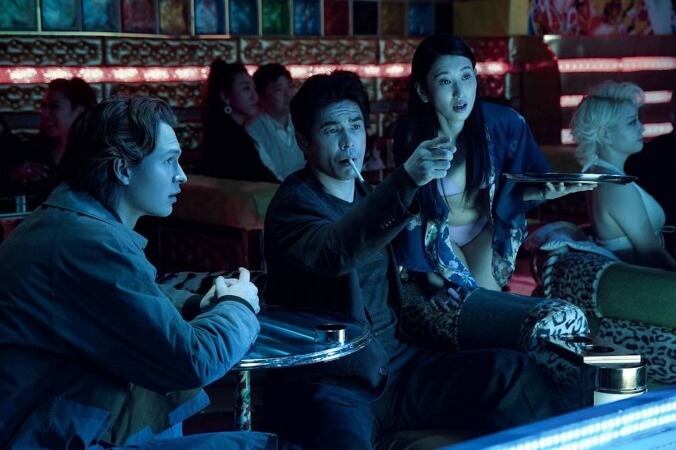Ansel Elgort and Hideaki Itō in Tokyo Vice Photo: Eros Hoagland/HBO Max
Michael Mann has spent his career in Vice. Nearly 40 years ago, the famed director explored the relationship between undercover cops and overpowered gangsters on Miami Vice. In the aughts, he updated that TV phenom for the big screen. And today, he’s he’s helping shepherd HBO Max’s Tokyo Vice through a neon-soaked, yakuza-run underground.
Loosely adapted from Jake Adelstein’s memoir, Tokyo Vice: An American Reporter On The Police Beat In Japan, the crime thriller follows the early days of Adelstein (Ansel Elgort) on the police beat of Japan’s largest fictional newspaper, Meicho Shimbun. He’s the paper’s only gaijin (“foreigner” in Japanese) reporter, and, boy, do they let him know it. In his interview for the gig, for instance, the hiring manager asks how Jake, a Jew, feels about people on staff believing Jews control the economy.
Tokyo Vice opens in media res. Two years into Adelstein’s career, he and Detective Hiroto Katagiri (Ken Watanabe) are meeting with the leaders of the Tozawa-led yakuza. Mann’s playing the hits here, evoking Miami Vice’s Sonny Crocket (Colin Farrell in the film), with Elgort’s slicked-back hair and boxy blazer. We get a taste of a deliciously seasoned Jake before we’re abruptly sent back to 1999 when his hair was unkempt and future uncertain.
Mann, who directed the pilot and serves as an executive producer, wastes no time ratcheting up the tension. In one early scene, a shot begins on the ground, then rises as Katagiri enters the room and perches right on his shoulder, then closes up on Watanabe. The framing is so tight, you can almost see the sweat in Watanabe’s pores. The score by Saunder Jurriaans and Danny Bensi also has a propulsive energy as we move from the mundane chaos of Meicho to the futuristic luxury of the Onyx hostess club.
The show fits Mann’s work beyond the title, though. A classic Mann protagonist, Jake is an over-eager workaholic, an “action is the juice” guy. Like the leads of Blackhat, Heat, and fellow journalism thriller, The Insider, Jake infiltrates networks by internalizing rules and procedures.
Understandably, viewers might raise eyebrows at a show about Japan told from the perspective of a white star, a white pilot director, and a white creator (J.T. Rogers). Shades of Isle Of Dogs notwithstanding, the series, shot on-location, feels like a tour of Tokyo but rarely dips into cultural tourism. Instead, the interior lives of characters are given space to come alive. Katagiri, for example, radiates love and kindness with his two children. Hearts should melt watching him sing the “Kaeru No Uta” or “Frog’s Song” to them.
Episode two, directed by Josef Kubota Wladyk, establishes what a difficult time it is on the police beat. A fracturing truce between rival yakuza gangs, the Chikara and the Tozawa, brings war to Katagiri’s doorstep. Jake endears himself to Katagiri and Sato (Shô Kasamatsu), a Backstreet Boy-loving Chikara captain, and finds himself on a path into the yakuza underground. (We should point out: Of the show’s grimacing yakuza soldiers, Sato is the most captivating. His cool drips off the screen, but his insecurities bubble just below the surface.)
At Meicho, Jake works under veteran editor Eimi (Rinko Kikuchi). Seeing Jake’s persistence, she aids his investigation into an uptick in suicides by people indebted to a yakuza-tied loan sharking operation. Director Hikari makes the best use of Kikuchi in the standout, All The President’s Men-inspired fourth episode, expertly balancing Mann’s process-oriented obsessions with the actor’s surprising performance.
Speaking in Japanese and English, Elgort lives up to the charisma he was supposed to bring to Baby Driver and West Side Story, beaming with excitement as he gum-shoes his way through the Tokyo underworld. But his best moments occur sitting across the table from his colleagues, trading horror stories over beers, cigarettes, and sushi. (It’s admittedly difficult to see Elgort’s charms through the cloud of controversy that stalks his work.)
Jake’s personal life is the show’s weakest element. J.T. Rogers teases the journalist’s Missouri roots as he avoids calls from mom and listens to taped messages from his sister. We need Jake’s motivations for working in Japan, but these character breadcrumbs feel like prestige-series obligations, not answers. Rogers leads us towards a big reveal, but Jake’s history fails to hook.
At its best, Tokyo Vice drags the viewer’s arm through the bars, alleys, offices, and homes of the city’s many classes and communities, providing a rounded picture of a place that leaves room for the thrill of exploration and discovery. That’s what good journalism is supposed to do, right? Bring the world to your front door? Tokyo Vice does that, with a sleek, energizing style that keeps us wanting more.

